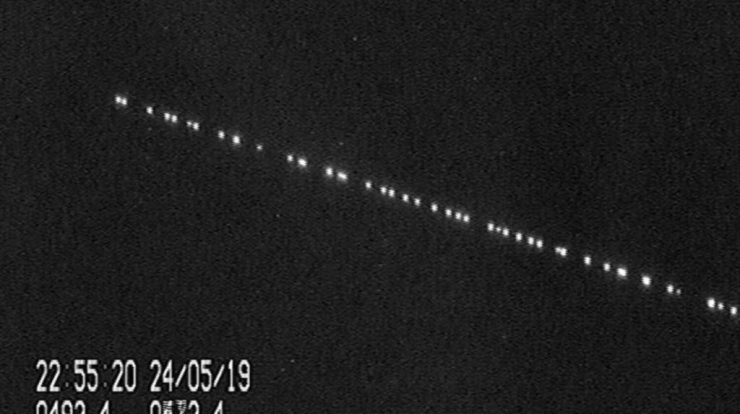

Marco Langbrook
Starlink satellites were seen after their first launch in May 2019
If you’ve looked up at the night sky lately, you might be surprised to see a train of bright lights moving back and forth. What is happening? The lights appear in groups of 60 in a long row. There have been numerous reports from places like the US and UK of people seeing it, with explanations ranging from UFOs to an alien invasion. it is clear. But do not be afraid. These lights are actually satellites, which were launched into space by the American company SpaceX, run by South African businessman Elon Musk. And they are a bit controversial.
Satellite is part of Starlink. This is the SpaceX project to launch thousands of satellites into orbit and broadcast the Internet to Earth from space. SpaceX hopes to use it to fund missions to Mars. Since the first launch in May 2019, SpaceX has launched about 360 of these satellites. Each weighs about 260 kilograms and is about the size of a flat car, with a large solar panel that reflects sunlight.
Read more: Elon Musk announces Starlink to connect 19,000 schools and monitor the Amazon
The ultimate goal of SpaceX is to cover the space around the Earth on these satellites. They plan to have 12,000 Starlink satellites in orbit and possibly as many as 42,000. This is known as a mega constellation. The satellites are being launched in batches of 60, with SpaceX aiming to launch about two per month — although it hasn’t yet reached that frequency. Each time the satellites are launched, the company’s reusable Falcon 9 rockets are placed into orbit 290 kilometers above the Earth’s surface.
The satellites then use their onboard ion engines to raise their altitude to their operational orbits between 340 and 550 kilometers. This may take several months. During these months, satellites can appear very clearly in the night sky when flying over your location due to their reflective surfaces. After dusk and before dawn, when the sun drops directly below the horizon, satellites reflect sunlight back to Earth, causing it to shine brightly. As they pass through the sky, they appear as a bright train of lights as satellites follow one by one in orbit.
SpaceX’s goal with Starlink is to broadcast high-speed internet to all locations on Earth, from London to Antarctica. People will then pay a fee to access the service, with estimated speeds slower than fiber broadband but faster than current satellite internet services. However, people have raised concerns about the number of satellites that SpaceX is launching. Today with only about 2,000 active satellites orbiting the Earth, SpaceX will increase that by six times and perhaps 21 times.
Read more: How Elon Musk’s visit affects Amazon digital plans
This poses a great danger to satellites that collide in Earth’s orbit. If two satellites collide, they can explode and produce thousands of tiny pieces of debris. This happened in 2009 between an American and a Russian satellite. Each piece of this debris can also affect other satellites. This could lead to a worst-case scenario where parts of Earth’s orbit become unusable, known as “Kessler Syndrome”, and spread to Gravity.
Another concern is that the satellites are extremely bright and exceed 99% of all other satellites in the night sky. For this reason, astronomers report that these satellites hinder their ability to study the universe. Satellites can appear as bright bands in telescope images, destroying observations of galaxies and stars. With so many satellites scheduled to launch, astronomers have raised concerns about how many will be visible in the night sky.
According to some estimates, hundreds of Starlink satellites can be constantly visible in the night sky from anywhere on Earth. This can spoil the natural beauty of the night sky and make astronomy more difficult. There are currently no laws or regulations protecting the aesthetics of the night sky. But some people are looking to change that and possibly take legal action against SpaceX.
Read more: SpaceX beats launch record with Starlink mission
For its part, SpaceX says it is addressing these concerns. Regarding collisions, it says all of its satellites are equipped with an automated system to distract other satellites. However, in September 2019, this system failed, which led to a close confrontation with a European scientific satellite. The company also says it is trying to make the satellites dimmer. In January 2020, it launched a Starlink satellite that was covered in dark paint, in an attempt to reduce its reflection. Preliminary results indicate that when it reached its operational orbit, this satellite appeared darker than other Starlink satellites. However, it looked shining in the months it took to reach this orbit.
The company is also working with astronomy groups to try to find ways to reduce the impact of the Starlink satellites on the work of astronomers. However, Elon Musk said he believes there will be no “zero” problems. So far, SpaceX has launched 3% of its initial planned fleet of 12,000 satellites and 0.9% of the 42,000 it could launch. There are some arguments that many problems with satellites had to be resolved before SpaceX could begin launching them.
However, at the moment, there are no rules or regulations that prevent SpaceX from launching more and more Starlink satellites into orbit. Before the outbreak of the coronavirus pandemic, the company planned to launch about 1,500 Starlink satellites by the end of 2020, bringing its online service first in the United States and Canada. That could change now. But for now, you will likely continue to see satellite trains in the night sky. You can use sites like Find Starlink or this handy tool to see when it will be visible above your location.
>> Apply or nominate someone for the under 30 selection for 2022

“Friendly zombie guru. Avid pop culture scholar. Freelance travel geek. Wannabe troublemaker. Coffee specialist.”






